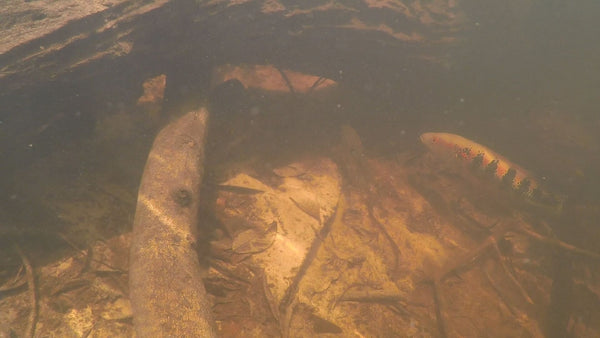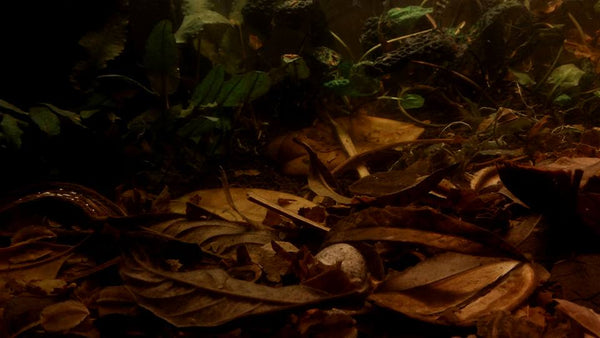- Continue Shopping
- Your Cart is Empty
Postcards from the bottom...
Not long ago, our friend Mike Tuccinardi shared some wonderful photos he took underwater in the Rio Negro, which we featured here in "The Tint." Not only were the photos simply cool to look at- they gave us a lot of ideas on how to create natural-looking scenes, and in my mind, validated the aesthetic and "craft" of the botanical-influenced aquarium as a more realistic representation of what you might encounter at the bottom or lower levels of the water column in a habitat such as Amazonia.
Yeah, the bottom. Something we take for granted in most aquaecapes...It's sand and a few rocks...and that's it.

The two things that really struck me about these images were that the amount of botanical material accumulating on the bottoms of these streams is significant, and surprisingly diverse. Sure, the dominant materials present are leaves, yet there are significant quantities of stuff like seed pods, roots, bark, and tree branches.

And the interesting thing that I noticed is that the majority of the fishes present in these environments truly seem to interact with them, utilizing the botanical materials as either foraging areas, hiding places, or nurseries. Sure, you see fishes such as Characins schooling in open water near the surface, but a surprisingly large number of the fishes present seem to associate very closely with the botanical cover itself.

The pic above with the Cichlid is very telling. The fish is staying very close to the bottom, in this case, a little break in the leaf litter exposing some sand. They do a lot of foraging at the bottom, as well as courtship, spawning, and other activities, and the botanical materials provide some cover, territory, "meeting spaces", and of course, food sources- mainly insects, worms, and small crustaceans.
I notice this behavior in my aquariums with Apistogramma. They will come out into the water column, but prefer not to stray very far from the leaves and botanical materials at the bottom of the aquarium.
It's no secret that many Apisto breeders use Catappa leaves and such extensively in their aquariums, ostensibly to help impart beneficial tannin and humic substances into the water, but from a more "functional" standpoint, they provide the same level of comfort, protection, spawning area, and foraging as they do in the wild. A perfect example of how configuring an aquascape for your fishes can bring out their natural behaviors.

There is something extremely simple about the concept, yet i suspect that many of us as aquarists approach design of our aquaecapes from a purely aesthetic standpoint. Nothing wrong with that, of course, but think of how interesting it is to consider the actual lifestyles of the fishes we keep, and how more closely replicating the bottom structures can foster the natural behaviors we crave while still creating an amazing aesthetic!

The next couple of "postcards from the bottom" once again drive home the fact that natural habitats from where our fishes come from are not the sterile, pristine-appearing utopias that we like to represent in international aquascaping contests.

Rather, they are diverse harbors of life, ranging from fungal and biofilm mats, to algae, to epiphytic plants. Decomposing leaves, seed pods, and tree branches compose the substrate for a complex web of life which helps the fishes we're so fascinated by flourish. And, if you look at them objectively and carefully, they are beautiful.

It's truly a matter of perspective, when considering the appearance of these biotope components. The "mental stretch" we talk about so often, urging hobbyists to take a look at what a natural habitat really looks like before simply asserting that they've created a "natural aquarium" because there are a few well-placed rocks and plants present , is also a sort of "maturity", in my opinion. In an aquarium setting, it's an aesthetic that is not for everyone, but it is a far, far more realistic portrayal than what we've assigned this moniker to in the past.

And of course, rocks and stones are present in these waters. However, you'll note that they typically take the form of boulders, encrusted with biocover- not unlike what you'd see in Lake Malawi! And you can clearly see the fishes foraging on the biocover (do we dare use the term aufwuchs?) in the photo below. And of course, never far from the rocks are tangled tree branches, roots, and other botanicals.

The study of these pics and others can give us a lot of interesting clues when planning our next aquarium, particularly if we really want to create a more "natural" aquarium from both an aesthetic and functional standpoint, particularly when considering what the bottom of a natural stream really looks like in these waters.
All in all, the practice of utilizing diverse natural materials in our aquaecapes, beyond the traditional rocks, plants, and driftwood, has opened up a treasure trove of aesthetic and functional aquarium design possibilities. When drawing inspiration fro the natural environment, and applying our own creativity, the potential for more dynamic displays than ever before, highlighting all zones of the aquarium, is huge!

Once again, I encourage you to study the natural environment, particularly niche habitats or areas of the streams, rivers, and lakes- and draw inspiration from the functionality of these zones. The aesthetic component will come together virtually by itself. And accepting the varied, diverse, not-quite-so-pritinh look of the "real thing" will give you a greater appreciation for the wonders of nature, and unlock new creative possibilities.
Stay inspired. Stay open-minded.
Stay Wet
Scott Fellman
Tannin Aquatics








Scott Fellman
Author